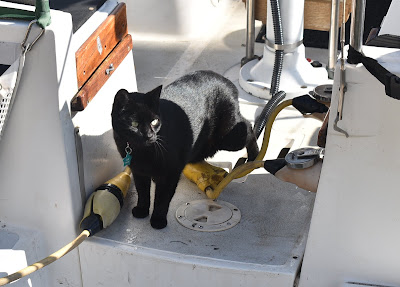 |
| Arriving back at Kemah after our adventures in Galveston |
Although our long-anticipated voyage to Florida and beyond has bitten the dust (due to incessant problems), that does not mean that we are dumping Dragonfly right away. After much discussion, Joan and I have decided to hang onto her for a while. That means we can take some day-sails, and put Dragonfly thru the paces and see how she performs, out in the real world.
 |
| Em and Julian |
So yesterday (Sunday), the planets aligned properly, the afternoon lunar tides were favorable, and the winds were out the southeast. So again we drafted our marina neighbors Julian and Em as extra crew, and successfully untied the dock lines and headed for Galveston Bay.
It was one heckuva sail. When we got out into the bay, I went ahead and raised the full main and unfurled the genoa all the way. But the wind was blowing about 20 knots! All sailors should know this cardinal rule: if you THINK that just maybe you should reef in your sails, then reef them, gosh-darn it! ("Reef" means to reduce the area of sail exposed to the wind.) Dragonfly's sails were terribly over-powered, and we were heeling over like crazy. Joan does not particularly like big-time heeling, and made here objections known. I had to make the tough call to hand the helm to someone else with instructions to motor into the wind, and then clamor up to the foredeck to reef the mainsail while the waves battered us. Not fun.
 |
| Going under the Kemah bridge |
Another tough lesson we learned was that, when heeled over in heavy seas, objects aboard your boat will find a way to, shall we say, go where they don't belong. Down below, some cabinets with not-so-secure latches came open and spilled their contents onto the floor. (Cue sounds of mayhem.) Above deck, my dinghy chock (which is not needed when the dinghy is back at the harbor) tried really hard to escape overboard.
 |
| Jam session after the sail |
So all in all, it was a good shakedown sail. Nothing big broke, no one fell overboard, and I even maneuvered in and out of our marina slip like a pro! In the end, a good time was had by all. I wish it had occurred long ago, but mother nature wouldn't cooperate.
Oh, and we still have not raised up the spinnaker. Some day.
 |
| Snow learning how to be a good boat cat |
 |
| While in Galveston, the deck needed a good cleaning. |


Windward weather helm on gusts means unbalanced sail plan with a main sail being overpowered vs the headsail, either because the surface is unbalanced, or because the sheets needs to be adjusted. Sailing with more than 10° of rudder is similar to driving a car with the parking break on. I wish you luck figuring out how DragonFly works under sail, that's another exciting journey :)
ReplyDelete